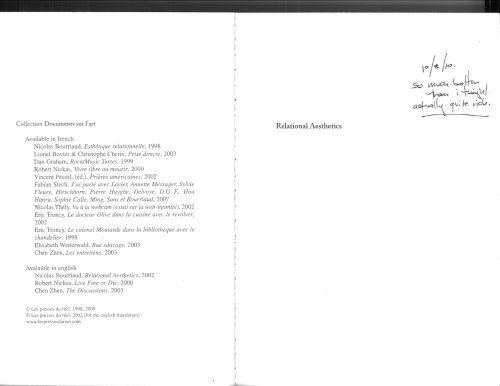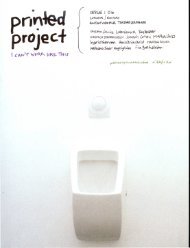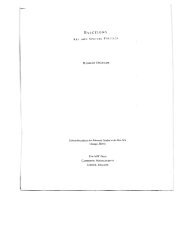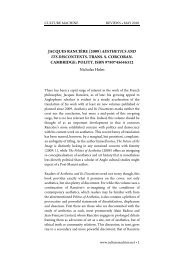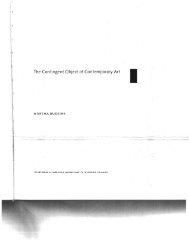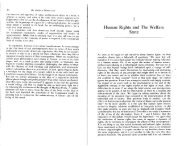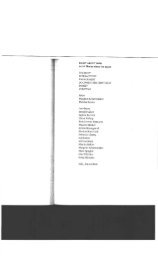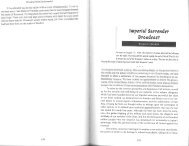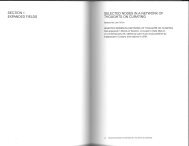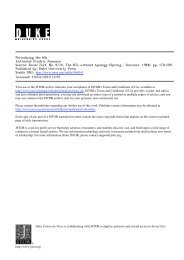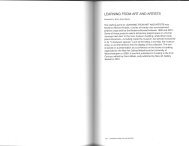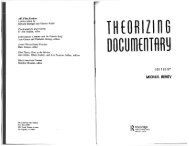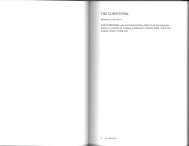Relational Form - doublesession
Relational Form - doublesession
Relational Form - doublesession
You also want an ePaper? Increase the reach of your titles
YUMPU automatically turns print PDFs into web optimized ePapers that Google loves.
Collection Documents sur I'art<br />
Available in french<br />
Nicolas Bourriaud, Esthétique relationnelle, 1998<br />
Lionel Bovier & Christophe Cherix, Prise directe,2003<br />
Dan Graham, RocUMusic Textes, 1999<br />
Robert Nickas, \/ivre Libre ou mourir,20O0<br />
Vincent Pécoil, (éd.), P rière s américaines, 2002<br />
Fabian Stech, J'ai parlé avec lnvier Annette Messager Sylvie<br />
Fleury, Hirschhorn, Pierre Huyghe, Delvoye, D.G.-F., Hou<br />
Hanru, Sophie Calle, Ming, Sans et Bourriaud,2007<br />
Nicolas Thély,Vu à lawebcam (essai sur laweb-intimité),2002<br />
Eric Troncy, Le docteur Olive dans Ia cuisine avec le revolver,<br />
2002<br />
Eric Troncy, Le colonel Moutarde dans la bibliothèque avec le<br />
chandelier, 1998<br />
Elisabeth Wetterwald, Rue sauvage, 2003<br />
Chen Zhen, Les entretiens,2003<br />
Avalaible in english<br />
Nicolas Bourriaud, Re lational Ae st hetic s, 2O02<br />
Robert Nickas, Live Free or Die,2000<br />
Chen Zhen, The Discussions,2O03<br />
O Les presses du réel, 1998, 2009<br />
O Les presses du réel, 20O2 (for the english translation)<br />
www.lespressesdureel.com<br />
<strong>Relational</strong> Aesthetics
Foreword<br />
Where do the misunderstandings surrounding 1990s' art come<br />
from, if not a theoretical discourse complete with shortcomings?<br />
An overwhelming majority of critics and philosophers are reluctant<br />
to come to grips with contemporary practices. So these remain<br />
.essentially<br />
un¡eadable, as their originality and their relevance<br />
ins them on the basis of<br />
are beins raised these davs by afists. What are the real challenges<br />
of contemporny art? What are its links with society, history and<br />
culture? The critic's primary task is to recreate the complex set of<br />
problems that a¡ise in a particular period or age, and take a close<br />
look at the various answers given. Too often, people are happy<br />
drawing up an inventory of yesterday's concerns, the better to<br />
lament the fact of not getting any answers. But the very first<br />
question, as far as these new approaches are concerned, obviously<br />
has to do with the material form of these works. How are these<br />
apparently elusive works to be decoded, be they process-related or<br />
behavioural by ceasing to take shelter behind the sixties art history?<br />
Let us quote several examples of these activities. Rirkrit Tiravanija<br />
organises a dinner in a collector's home, and leaves him all the<br />
ingredients required to make a Thaï soup. Philippe Parreno invites<br />
a few people to pursue their favourite hobbies on May Day, on a
factory assembly line. Vanessa Beecroft dresses some twenty<br />
women in the same way, complete with a red wig, and the visitoi<br />
lerelV ge_ts a glimpse of them through the doãrway. tvtau¡zio<br />
Cattelan feeds rats on "Bel paese,' ãh""r" and sells them as<br />
multiples, or exhibits recently robbed safes. In u Cop"Jug"n<br />
square, Jes Brinch and Henrik prenge Jacobsen install an upturñed<br />
bus that causes a rival riot in tne ãity. christine Hill works as a<br />
check-out assistant in a supermarkei, organises a weekly gym<br />
workshop in a gallery. ca¡sten Höller iecreates the chemical<br />
formula of molecules secreted by the human brain when in love,<br />
builds^an inflatable plastic yacht, and breeds chaffinches with thã<br />
aim of teaching them a new song. Noritoshi Hirakawa puts a small<br />
ad in a newspaper to find a girl to take part in his show. pierre<br />
Huyghe summons peopre to a casting session, makes a TV<br />
blic, and puts a photograph of<br />
few yards from the building site.<br />
the riveriest racror rhat is praved #tffi'5:n:.ïi#îi#ilÏi<br />
do with interactive, user-friendly and relational concepts.<br />
These days, communications are plunging human contacts into<br />
monitored areas that divide the social uono up into (quite) different<br />
products. Artistic activity, for its part, strives to achieve modest<br />
connections, open up (One or two) obstructed passages, and<br />
connect levels of reality kept apart from one another. The much<br />
vaunted "communication superhighways", with their toil prazas<br />
and picnic a¡eas, th¡eaten to heçs¡¡s the only possible ttrorouifrfare<br />
from a point ro anorher in the human world. îne soperhigt *ul _ãy<br />
well actually help us to travel faster and more efFróientty, y"tit t ".<br />
the drawback of turning its users into consumers of miles and their<br />
by-products. we feel meagre and helpless when faced with the<br />
electronic media, themg nar.kg, user_friéndly places, and the.pr*a<br />
of compatible forms of sociability, like the laboratory rat doàmed<br />
to an inexorable itinerary in its cage, littered with chunks of cheese.<br />
8<br />
The ideal subject of the society of extras is thus reduced to the<br />
condition of a consumer of time and space.<br />
For anything that cannot be marketed will inevitably vanish.<br />
Before long, it will not be possible to maintain relationships<br />
between people outside these trading areas. So here we are<br />
summonsed to talk about things around a duly priced drink, as a<br />
symbolic form of contemporary human relations. You are<br />
looking for shared warmth, and the comforting feeling of well<br />
being for two? So try our coffee... The space of current relations<br />
is thus the space most severely affected by general reification.<br />
The relationship between people, as symbolised by goods or<br />
replaced by them, and signposted by logos, has to take on<br />
extreme and clandestine forms, if it is to dodge the empire of<br />
predictability. The social bond has turned into a standa¡dised<br />
artefact. In a world governed by the division of labour and ultraspecialisation,<br />
mechanisation and the la'ù/ of profitability, it<br />
behoves the powers that human relations should be channelled<br />
towards accordingly planned outlets, and that they should be<br />
pursued on the basis of one or two simple principles, which can<br />
be both monitored and repeated. The supreme "separation", the<br />
separation that affects relational channels, represents the final<br />
stage in the transformation to the "Society of the Spectacle" as<br />
described by Guy Debord. This is a society where human<br />
relations are no longer "directly experienced", but start to<br />
become blurred in their "spectacular" representation. Herein lies.<br />
the most burnins issue to do with art toda)/: is it still possible to<br />
generate relationshins with the wnrld, in a nractical field art-<br />
was a reservoir of examples of what had to be tangibly<br />
"achieved" in day-to-day life, artistic praxis appears these days<br />
to be a rich loam for social experiments, like a space partly<br />
protected from the uniformity of behavioural patterns.The works<br />
we shall be discussing here outline so manv hands-on utopias.
Some of the following essays were originally published in<br />
magazines -for the most part in Docuàents sur l,art, and.<br />
exhibition catalogues', but have been considerably reworked, not<br />
to say re-ordered, here. Others are previously unpublished. This<br />
collection of essays is also rounded off Uy u glossary, which readers<br />
may refer to whenever a problematic concept rears its head. To<br />
make the book that much easier to come to gdps with, may we<br />
suggest to turn right away to the definition of the word ,,Art,,.<br />
L. "Le paradigme esthétique (Férix Guattari et L'art)" was pubrished by the magazine<br />
chimères,1993; "Reration écran" was published in the catarogue for the 3rd Lyon<br />
Contemporary fu1 Biennial, 1995.<br />
10<br />
<strong>Relational</strong> form<br />
Artistic activity is a game, whose forms, patterns and functions<br />
develop and evolve according to periods and social contexts; it is<br />
not an immutable essence. It is the critic's task to study this activity<br />
in the present. A certain aspect of the programme of modernity has<br />
been fairly and squarely wound up (and not, let us hasten to<br />
emphasise in these bourgeois times, the spirit informing it). This<br />
completion has drained the criteria of aesthetic judgement we are<br />
heir to of their substance, but we go on applying them to presentday<br />
artistic practices. The new is no longer a criterion, except<br />
among latter-day detractors of modern art who, where the muchexecrated<br />
present is concerned, cling solely to the things that their<br />
traditionalist culture has taught them to loathe in yesterday's art.<br />
In order to invent more effective tools and more valid viewpoints,<br />
it behoves us to understand the changes nowadays occurring in the<br />
social arena, and grasp what has already changed and what is<br />
still changing. How are we to understand the types of artistic<br />
behaviour shown in exhibitions held in the 1990s, and the lines of<br />
thinking behind them, if we do not start out from the same situation<br />
as the artists?<br />
Contemporary artistic practice and its cultural plan<br />
The modern political era, which came into being with the<br />
Enlightenment, was based on the desire to emancipate individuals<br />
and people. The advances of technologies and freedoms, the
^T'lú'<br />
decline of ignorance, and improved working conditions were all<br />
billed to free humankind and tritp to usher in ä b"tt", society. There<br />
are several versions of modernity, however. The 20th ""n,í.y *u,<br />
thus the arena for a struggle between two visions of the world: a<br />
modest, rationalist conception, hailing from the lgth century_angþ<br />
#Soqhy of. spontaneity and liberation through rhe irrational<br />
of history?<br />
evident that<br />
lt rs now re-formed on<br />
on this fi<br />
It is<br />
houdhon,<br />
because they are no longer presented like the precursory phenomena<br />
of an ineviøble historical evolution. Quite to the contary, they<br />
apryæ fragmentary and isolated, like orphans of an overall view of<br />
the world bolstering them with the clout of an ideology.<br />
It is not modernity that is dead, but its idealistic and teleological<br />
versron.<br />
Today's fight for modemity is being waged in the same terms as<br />
yesterday's, barring the fact that the avant-garde has stopped<br />
, patrolling like some scout, the troop having come to a cautious<br />
¡p, standstill around a bivouac of certainties. Art was intended to<br />
f<br />
prepare and announce a future world: today it is modelling possible<br />
*€ universes.<br />
The ambition of artists who include their practice within the<br />
3 slipstream of historical modernity is to repeat neither its forms nor<br />
its claims, and even less assign to art the same functions as it. Their<br />
task is akin to the one that Jean-François Lyotard allocated to postmodern<br />
a¡chitecture, which "is condemned to create a series oL<br />
minor modifr.cations in a space whose modernit! it inhpritt, ond.<br />
abandon an overall<br />
{<br />
t<br />
l<br />
å<br />
state of affairs: he defines it negatively. bv usins the term<br />
"condemne{". And what, on the other hand. if<br />
represented the historical<br />
to us manased to<br />
"chance" can be summed up in just a few words:<br />
learning to inhabit the world in a better way, instead of trying to<br />
construct it based on a preconceived idea of historical evolution.<br />
Otherwise put, the role of artworks is no longer to form imaginary<br />
and utopian realties, but to actually be ways of living and models<br />
of action within the existing real, whatever the scale chosen by the<br />
artist. Althusser said that one always catches the world's train on the<br />
move; Deleuze, that "gass grows from the middle" and not from<br />
the bottom or the top. The artist dwells in the circumstances the<br />
present offers him, so as to turn the setting of his life (his links with<br />
13
the physical and conceptual world) into a Iasting world. He catches<br />
the world on the move: he is a tenant of culture, to borrow Michel<br />
de Certeau's expression'. Nowadays, modernity extends into the<br />
practices of cultural do-it-yourself and recycling, into the invention<br />
of the everyday and the development of time lived, which are not<br />
objects less deserving of attention and examination than<br />
Messianistic utopias and the formal "novelties" that typifred<br />
modernity yesterday. There is nothing more absurd either than the<br />
assertion that contemporary art does not involve any political<br />
project, or than the claim that its subversive aspects a¡e not based<br />
on any theoretical terrain. Its plan, which has just as much to do<br />
with working conditions and the conditions in which curtural<br />
objects are produced, as with the changing forms of social life, may<br />
nevertheless seem dull to minds formed in the mould of cultural<br />
Da¡winism. Here, then, is the time of the "dolce utopia,,, to use<br />
Maurizio Cattelan's phrase...<br />
Armvork as social interstice<br />
The possibility of a rerational a¡t (an art taking as its theoretical<br />
horizon the realm of human interactions and its social context,<br />
rather than the assertion of an independent and private symbolic<br />
space), points to a radical upheaval of the aesthetic, cultural and<br />
political goals introduced by modern art. To sketch a sociology of<br />
this, this evolution srems essenrially from the bifh of a world-lide<br />
urban culture, and from the extension of this city model to more or<br />
less all cultural phenomena. The general growth of towns and<br />
cities, which took offat the end of the Seconã World War, gave rise<br />
not only to an extraordinary upsurge of social exchanges,-but also<br />
to much greater individual mobiliry (through the devãlopment of<br />
networks and roads, and telecommunications, and the gradual<br />
freeing-up of isola¡ed places, going with the openinglup of<br />
attitudes). Because of the crampedness of dwelring rpu"". in ttris<br />
urban world, there was, in tandem, a scaling_down of iurniture and<br />
objects, now emphasising a greater manoeuvrability. If, for a long<br />
74<br />
L-.<br />
period of time, the artwork has managed to come across as a luxury<br />
lordly item in this urban setting (the dimensions of the work, as<br />
well as those of the apartment, helping to distinguish between their<br />
owner and the crowd), the development of the function of artworks<br />
and the way they are shown attest to a growing urbanisation of the<br />
afistic experiment. What is collapsing before our very eyes is<br />
nothing other than this falsely a¡istocratic conception of the<br />
arrangement of works of art, associated with the feeling of<br />
territorial acquisition. In other words, it is no longer possible to<br />
regard the contemporary work as a space to be walked through (the<br />
"owner's tour" is akin to the collector's). It is henceforth presented<br />
discussion. The city bag_j¡shqred in and spread the hands-on<br />
, confasting with that dense and "ûouble-free"<br />
Rousseau, a jungle hampering any lasting encounter..Once raised to<br />
the power of an absolute rule of civilisation, this system of<br />
intensive encounters has ended up producing linked artistic<br />
practices: an art form where the substrate is formed by intersubjectivity,<br />
and which takes being-together as a central theme, the<br />
"encounter" between beholder and picture, and the collective<br />
elaboration of meaning. Let us leave the matter of the historicity of<br />
this phenomenon on one side: art has always been relational in<br />
varying degrees, i.e. a factor of sociability and a founding principle<br />
of dialogue. One of the virtual properties of the image is its power<br />
of linlcage (Fr- reliance), to borrow Michel Maffesoli's term: flags,<br />
logos, icons, signs, all produce empathy and sharing, and all<br />
generate bont. Art (practices stemming from nainting and<br />
sculpture which come across in the form of an exhibitionl turns out<br />
to be particularly suitable when it comes to e*pressingthis hands-<br />
On civilisation.hecatse iÍ tightens the space of relrtinnt ¡n'like'lY
of.private consumption, and also unlike theatre and cinema which<br />
bring small groups together before specific, unmistakable images.<br />
Actually, there is no live comment made about what is ,""n i,t "<br />
discussion time is put off until after the show). At an exhibition, on<br />
the other hand, even when inert forms a¡e involved, there is the<br />
possibility of an immediate discussion, in both senses of the term.<br />
I see and perceive, I comment, and I evolve in a unique space and<br />
time. At is the place that produces a specific sociabiliìy. Iiremains<br />
to be seen what the status of this is in the ,"t of ,,states of<br />
encounter" proposed by the city. How is an art focused on the<br />
production of such forms of conviviality capabre of re-launching<br />
the modern emancipation plan, by compiementing it? How ¿oes í<br />
permit the developmenr of new politicaland cultu;al designs?<br />
Before giving concrete examples, it is well worth reconsiãering the<br />
place of artworks in the overalr economic system, be it symboiic or<br />
material, which governs contemporary society. Over aná above its<br />
mercantile nature and its semantic value, the work of art represents<br />
a social interstice- This interstice term was used by Karl i¿-^ to<br />
describe trading communities that elude the capitalist economic<br />
context by being removed from the law of profit: barter,<br />
possibilities than those in é within this<br />
t6<br />
an rnter-human commerce<br />
other tradin<br />
\-__<br />
d<br />
J \iñþ<br />
F<br />
)\ ùb<br />
tò<br />
6<br />
iT<br />
J<br />
i<br />
4 I<br />
VO<br />
H\)<br />
JÙ<br />
çü<br />
¿v1<br />
neighbourhood relationships fizzle. @<br />
social functions gradually reduces the relatioq4l . Just a few<br />
beines. but now we are woken<br />
automatic cash machine has<br />
are modelled on the effrciency of the<br />
move into the relational realm bv turning it into an iqsrrc.<br />
When Gabriel Orozco puts an orange on the stalls of a deserted<br />
Brazilian ma¡ket (Craay Tourist,1991), or slings a hammock in the<br />
MoMA garden in New York (Hamoc en Ia moïu4 1993), he is<br />
operating at the hub of "social infra-thinness" (l'inframince social),<br />
that minute space of daily gestures determined by the<br />
superstructure made up of "big" exchanges, and defined by it.<br />
Without any wording, Orozco's photographs are a documentary<br />
record of tiny revolutions in the common urban and semi-urban life<br />
(a sleeping bag on the grass, an empty shoebox, etc. ). They record<br />
this silent, still life nowadays formed by relationships with the<br />
other. When Jens Haaning broadcasts funny stories in Turkish<br />
through a loudspeaker in a Copenhagen square (Turkish Jokes,<br />
1994), he produces in that split second a micro-community, one<br />
made up of immigrants brought together by collective laughter<br />
which upsets their exile situation, formed in relation to the work<br />
and in it. The exhibition is the special place where such momentary<br />
groupings may occur, governed as they are by differing principles.<br />
And depending on the ired<br />
the nature of the works and the
C-or.*c¡^ac- -+ 1"",.^n I ",-W*¿rg ^,^.!- J -!*<br />
-s þo-r ?a.oùræ--l-Þ\ .(- ^/,+ìff"t14' ì"fto|*.n-<br />
other words, by analysing the coherence<br />
and of the i<br />
artlst must assume the symbolic models he shows. All<br />
representation (though contemporary art models more than it<br />
represents, and fits into the social fabric more than it draws<br />
inspiration therefrom) refers to values that can be transposed into<br />
society. As a human activity based on commerce, art is at once the<br />
object and the subject of an ethic. And this all the more so because,<br />
unlike other activities, i¡s sore function is to be exposed to th¡i<br />
commerce.<br />
Art is a state of encounter.<br />
<strong>Relational</strong> aesthetics and random materialism<br />
<strong>Relational</strong> aesthetics is part of a materialistic tradition. Being<br />
"materialistic" does not mean sticking to the triteness of facts, noî<br />
does it imply that sort of na¡row-mindedness that consisis in<br />
reading works in purely economrc terms. The philosophical<br />
tradition that underpins this rerationar aesthetic *ui d"fin"ã in u<br />
noteworthy way by Louis Althusser, in one of his last writings, as<br />
a "materialism of encounter", or random materialism. This<br />
particular materiarism takes as its point of departr¡re the world<br />
contingency, which has no pre_existing origin or sense, nor<br />
Reason, which might allot it a purpoie. So the essence of<br />
humankind is purely trans-individual, made up of bonds that link<br />
individuals together in social forms which a¡e invariably historical<br />
(Marx: the human essence is the set of sociar relations). There is no<br />
such thing as any possible "end of history" or "end of art,,, because<br />
the game is being forever re-enacted, in relation to its function, in<br />
other words, in relation to the players and the system which they<br />
construct and criticise. Hubet Damisch saw in the "end of arf'<br />
theories the outcome of an irksome muddle between the "end of the<br />
game" and the "end of play". A new game is announced as soon as<br />
the social setting radically changes, without the meaning of the<br />
18<br />
þ<br />
\--<br />
J<br />
f<br />
I<br />
v<br />
ð'<br />
å<br />
:-Þ I<br />
\<br />
lor a .à^æ1 .\ o^\, +-1 J û//r.<br />
game itself being challenged'. This inter-human gøze which forms<br />
our object (Duchamp: "Art is a game betvveen all people of all<br />
periods") nevertheless goes beyond the context of what is called<br />
"art" by commodity. So the "constructed situations" advocated by<br />
the Situationist International belong in their own right to this<br />
"game", in spite of Guy Debord who, in the final analysis, denied<br />
them any artistic character. For in them, quite to the contrary, he saw<br />
"art being exceeded" by a revolution in day-to-day life. <strong>Relational</strong><br />
aesthetics<br />
What do we mean by form? A coherent unit, a structure<br />
(independent entity of inner dependencies) which shows the typical<br />
features of a world. The artwork does not have an exclusive hold on<br />
it, it is merely a subset in the overall series of existing forms. In the<br />
materialistic philosophical tradition ushered in by Epicurus and<br />
Lucretius, atoms fall in parallel formations into the void, following<br />
a slightly diagonal course. If one of these atoms swerves off course,<br />
it "causes an encounter with the next atom and from encounter to<br />
encounter a pile-up, and the birth of the world"... This is how<br />
forms come into being, from the "deviation" and random encounter<br />
through this viable world state, because they get elements held apart<br />
a(ftLX + .1[ ,*ou!-1"
^UI<br />
r¡r)¡'¡'t<br />
to meet: for example, death and the media in Andy ìWa¡hol. Deleuze<br />
and Guattari were nor saying anything different when they defined<br />
the work of art as a "block of affects and percepts " . Ãrt keeps<br />
together moments of subjectivity associàted -with singuia.<br />
experiences, be it cézanne's apples or Buren's striped structureslThe<br />
composition of this bonding agent, whereby encountering atoms<br />
manage to form a word, is, needless to say, dependeni on the<br />
historical context. what today's informed public understands by<br />
"keeping together" is not the same thing t¡at ttris public imagineá<br />
back in the lgth century. Today, the "glue" is less obviour, uI ou.<br />
visual experience has become more complex, enriched by a century<br />
of photographic images, then cinematogaphy (introauction of thl<br />
sequence shot as a new dynamic unity), enabling us to recognise as<br />
a "world" a collection of disparate element (installation, for ii'staace)<br />
umts to<br />
be re-activated by the beholder- . I want to insist on<br />
instabilitv and the ¿iuerlñîG<br />
of soc<br />
mile Durckheim, considering the ".o"i¿@<br />
artistic "thing" sometime offers itself as a "fact" o. - "nr"rnble of<br />
facts that happens in the time or space, and whose unity (making it a<br />
form, a world) can not be questioned. The setting is widening;ãfter<br />
the isolated object, it now can embrace the whole scene: the fãrm of<br />
Gordon Matta-cla¡k or Dan Graham's work can not be reduced to<br />
the "things" those two artist "produce"; it is not the simple secondary<br />
effects of a composition, as the formalistic aestheúc would like tá<br />
advance, but the principle acting as a trajectory evolving through<br />
signs, objects, forms, gestures... flie contemporary artwork,s form<br />
is spreading out from its material form: it is a linking element, a<br />
principle of dynamic agglutination. An a¡twork is a dot on a line.<br />
20<br />
EÌ--j' ^\-.<br />
T b<br />
J<br />
-i<br />
<strong>Form</strong> and others'gaze<br />
If, as Serge Daney writes, "all form is a face looking at us", what<br />
does a form become when it is plunged into the dimension of<br />
dialogue? What is a form that is essentially relational? It seems<br />
worth while to discuss this question by taking Daney's formula as<br />
a point of reference, precisely because of its ambivalence: as forms<br />
are looking at us, how are we to look at them?<br />
<strong>Form</strong> is most often defined as an outline contrasting with a content.<br />
But modemist aesthetics talks about "formal beauty" by referring to<br />
a sort of (con)fusion between style and content, and an inventive<br />
comparibility of the former with the latter. we judge a work<br />
through its plastic or visual form. The most common criticism to do<br />
with new artistic practices consists, moreover, in denying them any<br />
"formal effectiveness", or in singling out their shortcomings in the<br />
"formal resolution". In observing contemporarv artistic practices.<br />
encounter<br />
proposition with other formations, artistic or otherwise.<br />
There a¡e no forms in nature, in the wild state, as it is our gaze that<br />
creates these, by cutting them out in the depth of the visible. <strong>Form</strong>s<br />
ate developed, one from another. What was yesterday regarded as<br />
formless or "informal" is no longer these things today. When the<br />
aesthetic discussion evolves, the status of form evolves along with<br />
it, and through it.<br />
In the novels of polish writer Witold Gombrowicz, we see how<br />
each individual generates his ownþrm through his behaviour, his<br />
way of coming across, and the way he addresses others. This form<br />
comes about in the borderline area where the individual struggles<br />
with the Other, so as to subject him to what he deems to be his<br />
"being". So, for Gombrowicz, our "form" is merely a relational<br />
property, linking us with those who reify us by the way they see us,<br />
to borrow a Sartrian terminology. When the individual thinks he is
As Daney suggested, form becomes "face" through the effect of<br />
this invention of relations. This formura, needless to add, calls to<br />
mind the one acting as the pedestal f.or Emmanuel Lévinas,<br />
thinking, for whom the face represents the sign of the ethical taboo.<br />
\-<br />
!<br />
-d<br />
ì<br />
ã<br />
-+=<br />
-Ë IsÈL<br />
-+ AI<br />
È<br />
+ .9<br />
s<br />
The face, Lévinas asserts, is "what orders me to serve another",<br />
"what forbids me 1o kill"l . Any "inter-subjective relation" proceeds<br />
by way of the form of the face, which symbolises the responsibility<br />
we have towa¡ds others: "the bond with others is only mqde as<br />
responsibility", he writes, but don't ethics have a horizon other than<br />
this humanism which reduces inter-subjectivity to a kind of interservility?<br />
Is the image, which, for Daney, is a metaphor of the face,<br />
only therefore suitable for producing taboos and proscriptions,<br />
through the burden of "responsibility"? When Daney explains that<br />
"allform is aface looking at us", he does not merely mean that we<br />
are responsible for this. To be persuaded of as much, suffrce it to<br />
revert to the profound significance of the image for Daney. For<br />
him, the image is not "immoral" when it puts us "in the place where<br />
we were not"t, when it "takes the place of another". What is<br />
involved here, for Daney, is not solely a reference to the aesthetics<br />
of Bazin and Rossellini, claiming the "ontological realism" of the<br />
cinematographic art, which even if it does lie at the origin of<br />
Daney's thought, does not sum it up. He maintains that form, in an<br />
image, is nothing other than the representation of desire. Producing ,<br />
a form is to invent possible encounters; receiving a form is to creafe.<br />
the conditions for an exchange. the wav vou return a service in a<br />
is flte representative of desire in the imaee. It is the horizon based<br />
on which the image mav have a meaning. bv pointinq to a desired<br />
based on which his own desire can rebound, This exchange can be<br />
summed up by a binomial: someone shows something to someone<br />
who returns it as he sees fit. The work tries to catch my gaze, the<br />
way the new-born child "asks for" its mother's gaze. In La Ve<br />
commune, Tzvetan Todorov has shown how the essence of<br />
sociability is the need for acknowledgement, much more than<br />
competition and violence'. When an a¡tist shows us something, he<br />
uses a transitive ethic which places his work between the "look-at-me"<br />
and the "look-at-that". Daney's most recent writings lament the
4<br />
end of this "Show/See" pairing, which represented the essence of<br />
a democracy of the image in favour of aìother pairing, this one<br />
TV-related and authoritarian, "promote/recelvË,,, mlting tfr"<br />
advent of the "Visual". In Daney's thinking, ,,all form fs ã ¡ac"<br />
looking et me", because it is summonrng -i to dialogue with it.<br />
levels<br />
l. Jean-François Lyotard: "The post modem explained to chi!àren',,London, Tuma¡ound,<br />
1992.<br />
1Á<br />
s<br />
þ<br />
t.õ<br />
t A.<br />
9<br />
-J<br />
-f<br />
Art of the 1990s<br />
Participatíon and trønsitivity<br />
A metal gondola encloses a gas ring that is lit, keeping a large bowl<br />
of water on the boil. Camping gears is scattered around the gondola<br />
in no particula¡ order. Stacked against the wall a¡e cardboa¡d boxes,<br />
most of them open, containing dehydrated Chinese soups which<br />
visitors are free to add the boiling water to and eat.<br />
This piece, by Rirkrit Tiravanija, produced for the Aperto 93 at the<br />
Venice Biennial, remains a¡ound the edge of any definition: is it a<br />
sculpture? an installation? a performance? an example of social<br />
activism? In the last few years, pieces such as this have increased<br />
considerably. In international exhibitions we have seen a growing<br />
number of stands offering a range of services, works proposing a<br />
precise contract to viewers, and more or less tangible models of<br />
sociability. Spectator "participation"- theorised by Fluxus happenings<br />
and oerformances. has become a constant feature of artistic oractice.<br />
As for the space of reflection opened up by Marcel Duchamp's "art<br />
coefficient", attempting to create precise boundaries for the<br />
receiver's held of activity in the afwork, this is nowadays being<br />
resolved in a culture of interactiviry which posits the transitivity of<br />
the cultural object as a fait accompli. As such, these factors merely<br />
ratify a development that goes way beyond the mere realm of art. The<br />
share of interactivity grows in volume within the set of<br />
25


